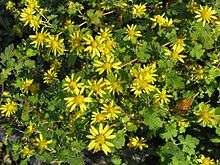Chrysanthemum indicum
| Chrysanthemum indicum | |
|---|---|
 | |
| Scientific classification | |
| Kingdom: | Plantae |
| Clade: | Angiosperms |
| Clade: | Eudicots |
| Clade: | Asterids |
| Order: | Asterales |
| Family: | Asteraceae |
| Genus: | Chrysanthemum |
| Species: | C. indicum |
| Binomial name | |
| Chrysanthemum indicum | |
| Synonyms | |
|
Several, including:
| |
Chrysanthemum indicum is a flowering plant commonly called Indian chrysanthemum,[2] within the family Asteraceae and genus Chrysanthemum.
General information
Chrysanthemum indicum grows up to 0.6 meters by 0.6 meters. It usually blooms from August to October. It must be grown outside under sunlight with moist soil. They normally have yellow or white flowers with yellow pollen. As Moul says, it is suitable for light (sandy), medium (loamy) and heavy (clay) soils. Suitable pH: acid, neutral and basic (alkaline) soils (Moul., n.d.).
Cultivation detail
Chrysanthemum indicum is a plant of the temperate zone but it can be grown successfully outside the area such as in tropical areas as it is often cultivated in Southeast Asia with moist soil (pH around 6.5) in sunny weather. It can handle temperatures down to -10°c. According to Julie Day, “Dig a hole at least twice the size of the root ball, and incorporate organic matter such as compost or peat to help with drainage. Plant the mums at exactly the same depth they were in the pot – avoid water collection around the stems. Space plants 18-24 inches apart (Day, n.d.).”
Propagation
Sow the seeds between the range of August to October. It usually start to grow in 10 – 18 days at 15°c but if it does not grow in 4 weeks, Useful Tropical Plants suggest you to, “try chilling the seed for 3 weeks in the salad compartment of a fridge (Useful Tropical Plants, n.d.).”
Uses (Edible uses, Other uses)
Inner uses
- The flower heads are pickled in vinegar.
- Flowers themselves can be used in beverages (Geg Huay).
- Young leaves can be used to make an aromatic tea.
(HUZHOU NBC BIOLOGICAL MATERIAL CO., LTD., n.d.).
Outer uses
- The seed contains about 16% of a semi-drying oil, but it’s not viable yet.
Medicinal
- Respiratory disease – Prepare plant decoction of Chrysanthemum indicum. Take 30 ml. twice a day.
- Fever – Make an infusion using flowers of Chrysanthemum indicum. Consume 28 ml. thrice a day when symptoms arise.
- Difficult menses – Consume 30 ml. of flower decoction once a day. Take it two days before your menstrual cycle begins.
- Flatulence – Boil 15 g. dried flowers of chrysanthemum indicum. Drink a cup of it once a day.
Thai use (Geg huay)
Production method
- Rinse the dried chrysanthemum flowers to remove any debris.
- Bring the water to a gentle boil, remove from the heat, and then add the chrysanthemum flowers. Allow the flowers to steep in the water until the drink is bright yellow in color, anywhere from 10-30 minutes. This will result in a strong floral flavor. If you prefer a less pronounced flavor, steep for less time.
- Srain the chrysanthemum drink to remove the flowers. Add sugar and stir to dissolve while the drink is still warm. Start with 2 tablespoons, and add more as necessary. This drink is also good without sugar, although those served in Thailand are typically quite sweet.
- Chill the chrysanthemum drink for several hours. Once it is cold, pour into a glass filled with crushed ice, and enjoy.
(Rachel, 2011)
References
[3] [4] [5] [6] [7] [8] [9] [10]
- ↑ Thunb. Arctotis 14 1799
- ↑ "Chrysanthemum indicum". Germplasm Resources Information Network (GRIN). Agricultural Research Service (ARS), United States Department of Agriculture (USDA). Retrieved 30 July 2014.
- ↑ "Today's Homeowner". Today's Homeowner. Day, Julie.
- ↑ "Herbpathy". Herbpathy. Herbpathy.
- ↑ "HUZHOU NBC BIOLOGICAL MATERIAL CO., LTD". HUZHOU NBC BIOLOGICAL MATERIAL CO., LTD.
- ↑ "Plants For A Future". Plants For A Future. Moul., (L.)Des.
- ↑ "Puechkaset.com". Puechkaset.com.
- ↑ "Rachelcooksthai". Rachelcooksthai. Rachel.
- ↑ "TeaSpring.com". TeaSpring.com.
- ↑ "Useful Tropical Plants". Useful Tropical Plants.